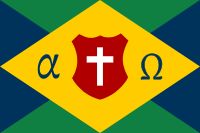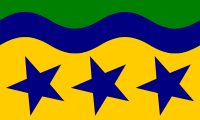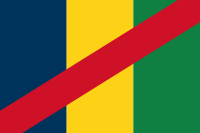Administrative divisions of Alora
Loading map... |
Alora is organized into 4 levels administrative subdivisions. There are the 3 administrative regions at the highest level. The country is further divided into 23 states (or estados in Castellanese speaking areas in western Takora). 11 of these states are located within the Alora region, 4 states lie within the region of Escaskia, and 9 states that lie within the region of Takora (also known as the Territory of Takora). States are further subdivided into either counties (or condados in Castellanese speaking areas in western Takora). The smallest incorporated divisions are cities, towns, and villages. which may be part of larger metropolitan areas or townships. Unincorporated divisions include communities and localities.
Regions
Regional levels of administration are managed at the national level. The regions within Alora do not have their own regional governments, constitutions, elected officials or legislative bodies and thusly are represented by the elected senators and representatives of the states which lie in each region. Regional administrators and justices are appointed by the central government at the direction of the executive branch and must be confirmed by the legislature. Regional governmental control is centralized in the capitol of Alora in Mopaso City but is also divided among administrative seats in each region which conduct the functions of regional administration in each region.
Capital: Mopaso City
Largest City: Mopaso City Population: xx,xxx,000 (2020) Other Major Cities/Towns: Staughley, Santa Carlina, Nolexo City, Adomaka, Aterramento, Gallaton, Pellahatchee Area: XXXXkm2 |
Capital: Athalan
Largest City: Athalan Population: x,xxx,000 (2020) Other Major Cities/Towns: Timbanusco, Nalmos City, Margonas, Koanau City, Annesburg Area: XXXXkm2 |
Capital: Takorado
Largest City: Takorado Population: xx,xxx,000 (2020) Other Major Cities/Towns: Tomale, Escuderos, Puerto Domenica, Bayon, Perdió Area: XXXXkm2 |
Territorial Possession
- The Territory of Takora - was a special administrative region that also has the distinction of being a territory. The Territory of Takora was created when Takora was adopted or annexed into the Union by ratification of the Aloran and Takoran Unification Treaty in 1974. This treaty placed Takora as a territorial possession of the nation of Alora and gave Takora its own limited governance under the authority of the Aloran Constitution and Legislature of Alora. Its capital, Takorado Served as the territorial capital until it officially became part of the Republic or Alora in 1998 and was designated as a region. Takora's status as territory is now symbolic. Takorado is the regional seat of Takora.
States and Capitals
States within Alora have their own governmental structure and limited sovereignty. Each of the 23 states have their own constitutions, elected governors, legislatures, elected officials, courts, judicial system and laws. The states while largely sovereign and independent are also subordinate to the national government and subject to the constitution of the Republic of Alora. In matters where the states constitution or statutes conflict with those of the republic then the constitution and statutes of Alora will override the state.
States are also organized into three branches of power. Executive with an elected governor, Legislative with either a bicameral or unicameral legislature and judicial branch as laid out in the constitutions of the individual states. Each state has its own capital which is the seat of government for each state. The capitals of each state are listed in the table.
Counties
Each state is made up of individual counties which provide a second level of administration below state control. Counties are somewhat autonomous but do not have their own sovereignty as the states due and are subject to the governance of the state in which they reside. County government is organized into county seats which serve as the administrative centers for each county. Each county has an elected body with a county commissar that serves as the executive head of the county commission. Counties are able to enact ordinances and resolutions which serve as laws and regulations for its jurisdiction. Each county has its own judicial system which is subordinate to the state's judicial system. Law enforcement duties are entrusted in an elected county sheriff, constable, or alguacil in Castellanese speaking areas, and have the authority to appoint deputies to carry out law enforcement duties.
Local Government
Local government within Alora is organized into incorporated and unincorporated communities. Incorporated communities include cities, towns and villages depending upon the charter by which they are incorporated. Cities are typically larger communities which have a common council and an elected mayor. Cities have more autonomy then do towns or villages. Towns are typically smaller than cities and have either an elected mayor or town manager that leads an town council. Villages are typically the smallest of the incorporated communities and have an elected council from which a manager is appointed. Incorporated communities often have their own police departments, services and municipal courts.
Unincorporated communities are administered by the county and do not have their own governmental structure, however some community associations exist that provide representation for larger unincorporated areas and can pass local bylaws. Law enforcement and most services are also handled by the county.


